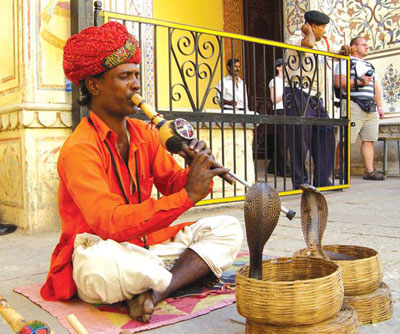|
|
|
|
Top India Destinations:
Mumbai (bombay) hotels Delhi hotels New Delhi hotels Bangalore hotels Jaipur hotels See more hotels in India
World Destinations:
 Guides » India » Nag Panchami - Snake Day Guides » India » Nag Panchami - Snake DayNag Panchami - Snake Day
Nag Panchami, otherwise known as “Snake Day” is an event in India celebrated in a number of different ways. For example, in the city of Mumbai, cobras are venerated and fed sweet milk, most often by women.
Many times, you can find a snake charmer like the one shown in the photograph on the streets that are more than happy to show off their skill. The Interesting thing about Nag Panchami is that Christians often see snakes as evil whereas the Hindu culture views snakes in a mixed light. In other words, they see snakes with fear but also as an important part of worship.  When looking at the king cobra in a positive manner, you will discover this snake is associated with Shiva and Vishnu, both gods, which means, “who drapes one around his neck” and “who reclines on one”, respectively. This particular Indian festival is a reflection of the Hindus mixed attitude toward the king cobra or any snake, as being both something to honor and adore while also something to respect and fear. When looking at the king cobra in a positive manner, you will discover this snake is associated with Shiva and Vishnu, both gods, which means, “who drapes one around his neck” and “who reclines on one”, respectively. This particular Indian festival is a reflection of the Hindus mixed attitude toward the king cobra or any snake, as being both something to honor and adore while also something to respect and fear.
Although considered a predominately, Hindu festival falling on the fifth day of the right half of Shravan, which would be in the months of July and August, everyone can enjoy the festivities. While most people feel an overwhelming sense of fear for the cobra, it might be translated to more of an awestruck respect. In addition to being a festival for Hindus, Nag Panchami is also associated with the legend of Lord Krishna, who as a child was able to gain victory over the roaring sea serpent called Kaliva. Some also believe that this time of year was chosen for Nag Panchami since it is the same time of year, when the snakes burrow out of their holes, finding themselves being washed with rainwater, as they seek out shelter in homes and gardens. Posing a threat to man, it could be that the Snake Day is a way to worship them. Keep in mind that during ancient Indian days, the culture of snake worship was common and known as Nagas. By legend, the 1,000-headed Shesh Nag symbolizes eternity. Known as the couch of Lord Vishnu, it is on this couch that the Lord reclines between the time of the dissolution of one universe and the creation of another universe. Since Hindus believe in immortality, this is also believed of the snake since it sheds its skin. For this reason, you will often see eternity in Hinduism being represented as a snake eating its own tail. No matter how you look at it, Nag Panchami is a very intriguing, although sometimes unnerving experience for tourists. However, as you watch the snake charmers so effortlessly handle the snakes, you cannot help to wonder what knowledge and power these people hold over such deadly creatures. Last Updated: 10/19/2006 3:14:00 PM Mode articles for India When visiting India, you will be met with clamor, diversity, and vastness. Although most people have a vision of what they expect India to be, remember that this country comes in many different forms. In other words,
When visiting India, you will be met with clamor, diversity, and vastness. Although most people have a vision of what they expect India to be, remember that this country comes in many different forms. In other words, ... continue >>  The famous Taj Mahal of India is located in a city called Agra, which at one time, was the capital of India. Located close to the Taj Mahal, the Agra Fort shares the same riverbank.
The famous Taj Mahal of India is located in a city called Agra, which at one time, was the capital of India. Located close to the Taj Mahal, the Agra Fort shares the same riverbank. ... continue >>  Just about everyone has heard of the Taj Mahal in India, a spectacular mausoleum of the Mughal Empress Mumtaz Mahal. From the swelling dome and square base people can always spot this symbol of India. The Taj Mahal is
Just about everyone has heard of the Taj Mahal in India, a spectacular mausoleum of the Mughal Empress Mumtaz Mahal. From the swelling dome and square base people can always spot this symbol of India. The Taj Mahal is ... continue >> |
|
| | |
|
©2025 HotelsRu.com About us Privacy Site map Visiting India |
|
 Look for deals on hotels?
Look for deals on hotels?